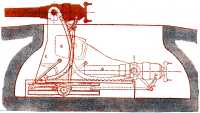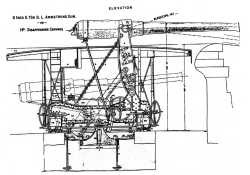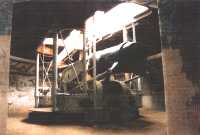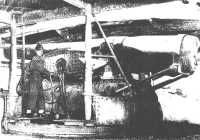|
Disappearing Gunsby Wally Ruffell | |||||||||||||||||||||||||||||||||||||||||||||||||||||||||||||||||||||||||||
|
The object of a 'disappearing' gun was to protect both detachment and equipment from hostile naval fire, achieved by arranging for the gun to recoil into an emplacement below ground level or behind a parapet. Originally proposed in the 1860s by Captain A. Moncrieff of the Edinburgh Militia, the first model appeared in 1871. It incorporated a mounting to the bottom of which was fitted a heavy counterweight as shown in Fig. 1. On firing the recoil overcame the resistance of the counterweight and the gun recoiled to the loading position where it was retained by a pawl. After loading the pawl was released, permitting the counterweight to bring the gun back to the firing position. Fig.1 features an Armstrong RBL 7-inch gun. Later RML 64-prs (6.3-inch) and 6.6-inch guns were mounted upon Moncrieff carriages.
During the early 1880s more sophisticated disappearing equipments were produced by Armstrong's Elswick 0rdnance Company (EOC). These employed a hydro-pneumatic (HP) system to control the recoil and at the same time to store enough energy to bring the gun back to the firing position. Indeed, Armstrong's HP system closely resembled in principle that of the modern recuperator. See Figs 2 and 3.
The idea of an installation which afforded protection to both equipment and detachment was commendable but from a gunnery point of view less praiseworthy. Disappearing 'carriages' were extremely ponderous and complicated pieces of machinery; records indicate that even a trained detachment took a minute and a half to get one round away from an 8-inch gun, far longer than with a similar gun on a central pivot mounting, such as the BL 6-inch Mk 7. When we recall that by the 1850s steam-powered warships were capable of 16 knots a hit would have been largely a matter of luck. Not only were the equipments of doubtful efficiency, their very size and complexity made them very expensive. In 1885 the New Zealand Government bought ten Armstrong BL 8-inch and thirteen 6-inch guns on disappearing carriages, the former at £6015 (pounds sterling), the latter at £3400 at London, while freight to the four main ports averaged �300 each. For details of estimated costs of installation including land, emplacements, magazines, barracks etc see the 1885 report to Parliament on harbour defence. Included in the estimates is an amount of £41,000 deducted for two and one half years' work by the N.Z. Armed Constabulary which should be noted. After 31 March 1885 men of the NZAC Field Force underwent training in coast defence and installed a number of RML 7-inch and 64-pr guns following the 'second Russian scare.' On 1 September 1886 AC Field Force and Reserves were given the option of joining the NZ Police or the NZ Permanent Militia (later Permanent Artillery). Those who chose the latter continued installing disappearing guns in a competent manner and without mishap, much to the amazement of Major General Harding Stewart RE, Military Adviser to the Agent General, who had recommended the employment of experts from England for the purpose '....as had been found necessary in Australia.' By the 1890s authorities began to wake up to the limitations of the equipments. A series of trials carried out in conjunction with the Royal Navy revealed it was virtually impossible for a warship to obtain a direct hit on what amounted to a 'pinpoint' target', i.e. a gun emplacement. Production of disappearing carriages therefore ceased and in 1912 they were declared obsolete in the British Army. However. other countries were captivated by the idea of disappearing guns, particularly the United States, where they were still being manufactured as late as 1919! In New Zealand they were manned during World War 1 but abandoned about 1925.
In 1929 it is understood the four BL 8-inch guns at Auckland were sold to a scrap merchant who struck financial difficulties and was unable to complete the deal, leaving behind the Summit Battery gun, the Fort Victoria gun, and the barrel of the South Battery gun cut up into several pieces. Prior to the visit of Queen Elizabeth II in 1953 the Summit Battery gun and carriage were shifted into the South Battery emplacement to form the 9 Coast Regiment Memorial Saluting Battery. See Figs 4 and 5. The Fort Victoria gun now rests in the loading position because during World War 2 local authorities vandalised the carriage by removing the massive HP recoil system which was of bronze. Of the four BL 6-inch guns, two at Fort Takapuna and two at Fort Bastion, the former were disposed of after World War 2. Of the latter it is believed one remains in its emplacement part of which became the tomb of the late Mr M.J. Savage. The piece of the other is at North Head. See Fig. 5. Here tribute must be paid to our forbears in the Armed Constabulary who installed the Summit Battery gun. When it was shifted to the South Battery position in 1953 personnel of 9 Coast Cadre who did the job found that every nut, bolt and screw had been greased prior to assembly! Thus the job was 'a piece of cake.'
When the guns were sold in 1929 the ammunition was ordered to be disposed of by dumping at sea, which was accordingly done. The job at Fort Victoria will be mentioned not only because it will raise a laugh but also because it will show the state of our defences at the time. The Master Gunner and his assistant had to move 200-lb shells from the magazine down a track to the road by means of a wheel-barrow, one at a time. As this method was both time-consuming and irksome they decided to roll them down the hill. They were making excellent progress when one of the shells came dangerously close to a house occupied by the local school-master who completely lost his sense of humour and threatened to report the Gunners to higher authority! Reluctantly they resumed with the wheel-barrow. The Fort Victoria gun fired only once during its lifetime; howls from Devonport residents who suffered a few broken windows silenced it for ever! Apparently most practice with the 8-inch guns was carried out with the South Battery equipment which had become badly worn by the end of its life. The late WOI Nelson Oram RNZA recalled that when a Territorial in 1910 as an ammunition number he had to fit 'bands augmenting' to each shell before loading. These were to increase the effectiveness of the existing driving bands in preventing the escape of propellant gas over the projectile, i.e. to counter excessive wear in the rifling. The Armstrong 6-inch guns were not a good buy. After New Zealand had bought and installed them an Ordnance Committee in the UK announced that they were unsafe to fire with full charges. To remedy the defect the Committee recommended the guns be returned to the UK to be 'chase hooped,' i.e. to have an additional tube shrunk over the chase of each to strengthen the barrel - at a cost of £700 each! However, the Commandant, NZ Defence Forces, Lt Col FJ Fox, in 1893 stated that with the exception of three the 6-inch guns were secondary armament "and will be quite sufficiently powerful when fired with reduced charges." He therefore recommended the three be returned to the UK for modification, which was accordingly done. Yet one wonders to-day how the supplier of a faulty product could get away with demanding payment from the customer for its repair. Sir William Armstrong, having been trained as a lawyer, had no doubt catered for that eventuality - and the New Zealand taxpayer footed the bill. Of the Wellington disappearing guns two BL 6-inch complete equipments from Fort Kelburne, Ngahauranga, were sent to the Army Museum in 1978 or 1979 when motorway construction through the fort area forced its dismantling. However, the pieces only are on display on makeshift mountings. At Fort Jervois, Ripapa Island, Lyttelton, (often called 'Ripa'), the original armament consisted of two 8-inch and two 6-inch disappearing guns, one of each of which were recommissioned during World War 2 and performed quite well - fortunately at practice only! Thanks to their later being abandoned by scrap merchants they may still be seen. Fort Taiaroa, at Taiaroa Head, Otago Peninsula, has its original 6-inch gun, also recommissioned during World War 2, and later completely restored by the Otago Antique Arms Association who claim it to be the only gun of its nature still in working order in the world. | |||||||||||||||||||||||||||||||||||||||||||||||||||||||||||||||||||||||||||
Most of the illustrations in this article are of 6-inch guns. However, the 8-inch were virtually identical except for size. See Fig. 8 for comparison. GENERAL DATA:
RANGE:No range tables are available but it is believed the maximum ranges were as follows: BL 6-inch 6600ft, BL 8-inch 8000ft. These would vary according the height of guns above mean sea level, i.e. the greater the height the greater the range. Accurate ranges were obtained by the depression range-finder (DRF) invented in 1873 and provided by the New Zealand Government. SIGHTS:(a) Tangent sights: These were actually open sights which resembled those fitted to field guns of the time. They were fitted to the gun itself and the layer had to stand on a sighting step when the gun was in action in order to operate them. Sight bars were graduated in yards and degrees of elevation, the latter to 12° only. For greater elevations the Watkin clinometer had to be used. (b) Index plate and graduated arc. This might be likened to indirect laying in field, i.e. elevation was set on the index plate on the gun while direction was obtained from a graduated arc on the gun floor. The latter read from zero to 360° and was oriented so that when the barrel of the gun pointed to true north the arc read zero. (c) Reflecting or mirror sights. These were attached to the elevators; how they were operated is not known. (d) Scott's telescopic sights were also provided. PROJECTILES:(a) Common shell. Of cast iron, later steel, common shell were filled with gunpowder, usually pointed with a percussion fuze in the base. (b) Shrapnel shell were used against personnel, personnel in small boats, or in the rigging of ships. They were normally time-fuzed. (c) Palliser shot were made of cast iron with pointed heads chilled to harden them. They were cast hollow and once intended to be used either as shot or shall but by 1895 were used as shot only, the cavity previously filled with gunpowder being filled with sand to maintain the weight. (d) Case shot were made of tinned steel lined with iron segments and filled with 'sand' (iron) shot packed in clay and sand. They were used against troops in the open or torpedo boats at short range. Effective ranges with full charge were 600 yards with 6-inch guns, 1000 yards with 8-inch. (e) Paper shot consisted of paper cylinders filled with 'dust' shot made to weigh the same as service projectiles. On firing the shot broke up, the 'dust' shot travelling about 250 yards. The idea was to test an equipment as firing a paper shot produced the same effect on the recoil system as firing a service projectile. CONVERSION IMPERIAL TO METRIC:
(a) Degrees to military mils: MULTIPLY BY 17.7777 HIGH EXPLOSIVE SHELL:HE shell filled with lyddite (picric acid) were first in action at the Battle of Omdurman by the British in 1898. It is believed some were imported into New Zealand at some time after 1895. WL Ruffell, March 2001 Return to top of article | More equipments | Guns around NZ | WL Ruffell | Home | |||||||||||||||||||||||||||||||||||||||||||||||||||||||||||||||||||||||||||







